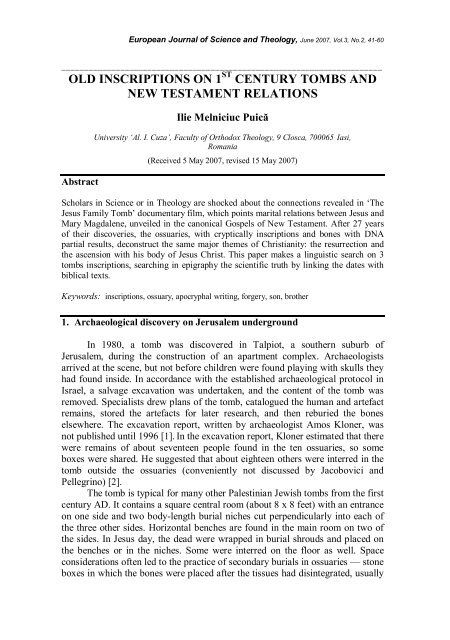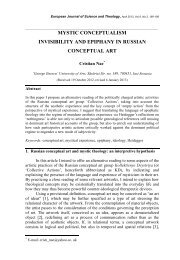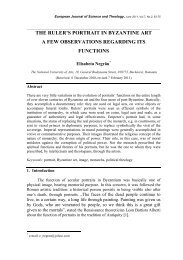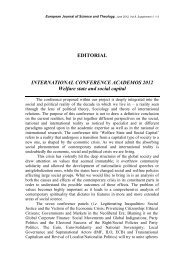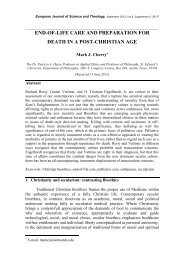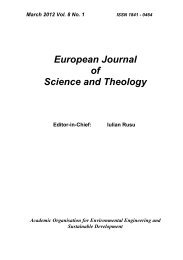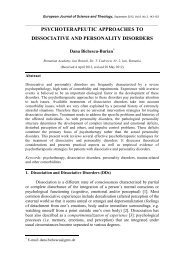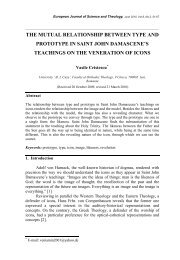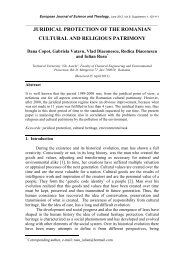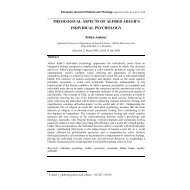Old inscriptions on 1st century tombs and New Testament relations
Old inscriptions on 1st century tombs and New Testament relations
Old inscriptions on 1st century tombs and New Testament relations
You also want an ePaper? Increase the reach of your titles
YUMPU automatically turns print PDFs into web optimized ePapers that Google loves.
European Journal of Science <strong>and</strong> Theology, June 2007, Vol.3, No.2, 41-60_______________________________________________________________________OLD INSCRIPTIONS ON 1 ST CENTURY TOMBS ANDNEW TESTAMENT RELATIONSAbstractIlie Melniciuc PuicăUniversity ‘Al. I. Cuza’, Faculty of Orthodox Theology, 9 Closca, 700065 Iasi,Romania(Received 5 May 2007, revised 15 May 2007)Scholars in Science or in Theology are shocked about the c<strong>on</strong>necti<strong>on</strong>s revealed in ‘TheJesus Family Tomb’ documentary film, which points marital relati<strong>on</strong>s between Jesus <strong>and</strong>Mary Magdalene, unveiled in the can<strong>on</strong>ical Gospels of <strong>New</strong> <strong>Testament</strong>. After 27 yearsof their discoveries, the ossuaries, with cryptically <str<strong>on</strong>g>inscripti<strong>on</strong>s</str<strong>on</strong>g> <strong>and</strong> b<strong>on</strong>es with DNApartial results, dec<strong>on</strong>struct the same major themes of Christianity: the resurrecti<strong>on</strong> <strong>and</strong>the ascensi<strong>on</strong> with his body of Jesus Christ. This paper makes a linguistic search <strong>on</strong> 3<strong>tombs</strong> <str<strong>on</strong>g>inscripti<strong>on</strong>s</str<strong>on</strong>g>, searching in epigraphy the scientific truth by linking the dates withbiblical texts.Keywords: <str<strong>on</strong>g>inscripti<strong>on</strong>s</str<strong>on</strong>g>, ossuary, apocryphal writing, forgery, s<strong>on</strong>, brother1. Archaeological discovery <strong>on</strong> Jerusalem undergroundIn 1980, a tomb was discovered in Talpiot, a southern suburb ofJerusalem, during the c<strong>on</strong>structi<strong>on</strong> of an apartment complex. Archaeologistsarrived at the scene, but not before children were found playing with skulls theyhad found inside. In accordance with the established archaeological protocol inIsrael, a salvage excavati<strong>on</strong> was undertaken, <strong>and</strong> the c<strong>on</strong>tent of the tomb wasremoved. Specialists drew plans of the tomb, catalogued the human <strong>and</strong> artefactremains, stored the artefacts for later research, <strong>and</strong> then reburied the b<strong>on</strong>eselsewhere. The excavati<strong>on</strong> report, written by archaeologist Amos Kl<strong>on</strong>er, wasnot published until 1996 [1]. In the excavati<strong>on</strong> report, Kl<strong>on</strong>er estimated that therewere remains of about seventeen people found in the ten ossuaries, so someboxes were shared. He suggested that about eighteen others were interred in thetomb outside the ossuaries (c<strong>on</strong>veniently not discussed by Jacobovici <strong>and</strong>Pellegrino) [2].The tomb is typical for many other Palestinian Jewish <strong>tombs</strong> from the first<strong>century</strong> AD. It c<strong>on</strong>tains a square central room (about 8 x 8 feet) with an entrance<strong>on</strong> <strong>on</strong>e side <strong>and</strong> two body-length burial niches cut perpendicularly into each ofthe three other sides. Horiz<strong>on</strong>tal benches are found in the main room <strong>on</strong> two ofthe sides. In Jesus day, the dead were wrapped in burial shrouds <strong>and</strong> placed <strong>on</strong>the benches or in the niches. Some were interred <strong>on</strong> the floor as well. Spacec<strong>on</strong>siderati<strong>on</strong>s often led to the practice of sec<strong>on</strong>dary burials in ossuaries — st<strong>on</strong>eboxes in which the b<strong>on</strong>es were placed after the tissues had disintegrated, usually
Melniciuc Puică/European Journal of Science <strong>and</strong> Theology 3 (2007), 2, 41-60in about a year. The ossuaries needed to be <strong>on</strong>ly as l<strong>on</strong>g as the l<strong>on</strong>gest b<strong>on</strong>e inthe body, <strong>and</strong> thus they allowed the space in the tomb to be used moreefficiently. Many ossuaries eventually c<strong>on</strong>tained the b<strong>on</strong>es of several people. Onabout 25% of the ossuaries, names were inscribed identifying the deceased.Ten ossuaries were found in the tomb, yet <strong>on</strong>ly nine were placed in thestorage facility of the Israel Antiquities Authority. The authors attempt to createa mystery over the absence of the tenth box <strong>and</strong> suggest that it was the <strong>on</strong>e thatis now owned privately <strong>and</strong> bears the inscripti<strong>on</strong> ‘James s<strong>on</strong> of Joseph brother ofJesus’. That ossuary created sensati<strong>on</strong> when it surfaced in 2002. Scientists haveidentified the James inscripti<strong>on</strong> as a modern forgery carved into an authenticancient ossuary [3].In a recent book were showed the profiles for the Jesus <strong>and</strong> Mariameneossuaries from the tomb <strong>and</strong> also for the James ossuary [4]. Spectroscopicanalyses revealed some discrepancies:1. The James ossuary has a small copper peak that is completely missing inboth Jesus <strong>and</strong> Mariamene ossuaries.2. The silic<strong>on</strong> peak in the James ossuary is substantially lower than the silic<strong>on</strong>peak in the Jesus <strong>and</strong> Mariamene ossuaries.3. The aluminium peak in the James ossuary appears to be quite a bit smallerthan the aluminium peak in the Jesus <strong>and</strong> Mariamene ossuaries.The archaeologists who excavated the tomb have stated that the tenthossuary was plain, with neither decorati<strong>on</strong> nor inscripti<strong>on</strong>, so it was not storedfor research but placed with other plain boxes in the courtyard of Jerusalem’sRockefeller Museum.The <str<strong>on</strong>g>inscripti<strong>on</strong>s</str<strong>on</strong>g> <strong>on</strong> the ossuaries found in the Talpiot Tomb are:1. Ossuary 80/500: ‘Mariamene e Mara’ – ‘Mariamne, also called Master’;2. Ossuary 80/501: ‘Yehuda bar Yeshua’ – ‘Judah, s<strong>on</strong> of Jesus’;3. Ossuary 80/502: ‘Matia’ – ‘Matthew’;4. Ossuary 80/503: ‘Yeshua bar Yehosef’ – ‘Jesus, S<strong>on</strong> of Joseph’;5. Ossuary 80/504: ‘Yose’ or ‘Yosa’ – a nickname for ‘Joseph’;6. Ossuary 80/505: ‘Maria’ – a Latinized versi<strong>on</strong> of the Hebrew ‘Miriam’;7. Ossuaries 80/506-508 were plain, with no <str<strong>on</strong>g>inscripti<strong>on</strong>s</str<strong>on</strong>g>.Of the ten ossuaries pulled from the niches of the burial chamber,<str<strong>on</strong>g>inscripti<strong>on</strong>s</str<strong>on</strong>g> were recorded as occurring <strong>on</strong> six. No <strong>on</strong>e knows anything reallyabout Ossuary 80/509. It disappeared before it could be checked for <str<strong>on</strong>g>inscripti<strong>on</strong>s</str<strong>on</strong>g>or ornamentati<strong>on</strong>.The fact that these names appear together is purely coincidental. Thenames of Joseph, Mary <strong>and</strong> Yeshua (Jesus) were comm<strong>on</strong> names of Jewishpeople living during the II Temple Period. Dr. Rahmani’s catalogue lists some895 ossuaries. Of these, 19 c<strong>on</strong>tain the name Joseph, 20 have Mary <strong>and</strong> 11Yeshua/Jesus in <strong>on</strong>e form or another in Hebrew, Aramaic, Greek or Latin.According to early traditi<strong>on</strong>, Joseph was buried in Nazareth [5, 6],possibly the ‘tomb of the saints’ <strong>on</strong> the property of the Sisters of Nazareth [7].Early traditi<strong>on</strong> also places Mary’s burial in Nazareth [6].42
<str<strong>on</strong>g>Old</str<strong>on</strong>g> <str<strong>on</strong>g>inscripti<strong>on</strong>s</str<strong>on</strong>g> <strong>on</strong> 1 st <strong>century</strong> <strong>tombs</strong> <strong>and</strong> <strong>New</strong> <strong>Testament</strong> relati<strong>on</strong>s2. Yeshua bar YehosefIn those days, family members were normally buried in their hometowns.In Jesus’ case, this would be Galilee, not Jerusalem. So if Jesus was notresurrected, we should be looking for his ossuary in Galilee. But if Jesus wasresurrected, we might expect to hear of traditi<strong>on</strong>s of burial in Jerusalem wherethe Christian Church was centred. And that is what we find.The traditi<strong>on</strong>al site of Jesus’ tomb in the Church of the Holy Sepulchrepredates since the 4th <strong>century</strong>. Eusebius reported that a st<strong>on</strong>e marked the burialspot of James, Jesus’ brother, by the Temple Sanctuary in Jerusalem. TheTalpiot tomb now being postulated is some distance away from where that spotwould have been. According to traditi<strong>on</strong> that goes back to the 6 th <strong>century</strong>, thereare two possible sites for Mary’s burial in Jerusalem, <strong>and</strong> the Talpiot tomb isn't<strong>on</strong>e of them. It is also interesting to note that the traditi<strong>on</strong>al burial spots of Jesus,James <strong>and</strong> Mary were all in different locati<strong>on</strong>s.In John 1.45 “Philip found Nathanael <strong>and</strong> told him, ‘We have found theman whom Moses wrote about in his teachings <strong>and</strong> whom the prophets wroteabout. He is Jesus, s<strong>on</strong> of Joseph, from the city of Nazareth.’” Philip thought, notknowing he was born in Bethlehem. See also John 6.42.Saint Joseph, also referred to as Joseph the Betrothed <strong>and</strong> as Joseph ofNazareth, was the legal father of Jesus, according to the <strong>New</strong> <strong>Testament</strong>(Matthew 1.16, Luke 3.23). Not much is known of Joseph except that he was ‘ofthe House of David’ <strong>and</strong> lived in the town of Nazareth. His date of death isunknown, though he was still living when Jesus was 12 years old. He is thepatr<strong>on</strong> saint of workers <strong>and</strong> has several feast daysHe was betrothed to Mary at the time that Mary c<strong>on</strong>ceived Jesus. SaintLuke says that he lived at Nazareth in Galilee (Luke 2.4); however, according toMatthew, it was <strong>on</strong>ly after the return from Egypt that he settled in Nazareth(Matthew 2.23). He is called a ‘just man’. He was by traditi<strong>on</strong> a carpenter(Matthew 13.55). He is last menti<strong>on</strong>ed in c<strong>on</strong>necti<strong>on</strong> with the journey toJerusalem, when Jesus was twelve years old. It is probable that Joseph diedbefore Jesus entered <strong>on</strong> his public ministry because <strong>on</strong>ly Mary was present at themarriage feast in Cana of Galilee, <strong>and</strong> he is not described at the crucifixi<strong>on</strong> al<strong>on</strong>gwith Mary (John 19.25). In additi<strong>on</strong> Joseph of Arimathea asked for the body ofJesus, a duty that would have fallen to Saint Joseph had he been alive.No early Christian would call Jesus the ‘s<strong>on</strong> of Joseph’. Fundamental tothe Christian message from the beginning was the belief that Jesus was the s<strong>on</strong>of God. For the sake of argument, even if Joseph was Jesus father, Jesusfollowers would not write that <strong>on</strong> his b<strong>on</strong>e box, because it c<strong>on</strong>tradicted the storythat they were telling publicly. For the same reas<strong>on</strong>, early Christians would notput Jesus name <strong>on</strong> a b<strong>on</strong>e box at all while they were announcing far <strong>and</strong> widethat his dead body had risen from the grave <strong>and</strong> ascended to heaven.43
<str<strong>on</strong>g>Old</str<strong>on</strong>g> <str<strong>on</strong>g>inscripti<strong>on</strong>s</str<strong>on</strong>g> <strong>on</strong> 1 st <strong>century</strong> <strong>tombs</strong> <strong>and</strong> <strong>New</strong> <strong>Testament</strong> relati<strong>on</strong>sRahmani’s catalogue lists the ossuaries with the name ‘Jesus’, with thenumbers 9, 63, 121, 140, <strong>and</strong> 704 [12]. The name ‘Jesus’ is found <strong>on</strong> theOssuary 80/501 from the Talpiot tomb, which reads ‘Judah, s<strong>on</strong> of Jesus’.Therefore, there are at least four other ossuaries whose occupant was a ‘Jesus’.When Rahmani read the inscripti<strong>on</strong>, he rec<strong>on</strong>structed the first <strong>and</strong> sec<strong>on</strong>d letters,y <strong>and</strong> š (sh), as c<strong>on</strong>jectures. He did so based <strong>on</strong> the fact that there was anotherYeshua inscripti<strong>on</strong> in the same family tomb. From Rahmani’s drawing, itappears that the letters of Yeshua (transliterated yšw‘) are probably present,written in some cases partially <strong>on</strong> top of each other. But I do not rule out thatlater <strong>on</strong>-site examinati<strong>on</strong>s may suggest a different name.Out of all of the <str<strong>on</strong>g>inscripti<strong>on</strong>s</str<strong>on</strong>g>, the <strong>on</strong>e attributed to Jesus is the mostdifficult to make out, <strong>and</strong> as a result the most difficult to interpret. Using thephotographs released by the Israeli Antiquities Authority <strong>and</strong> double-checkingmy work with that of Rahmani, I was able to piece together a line drawing of thedeepest lines carved into the ossuary. From that, mulled over the drawing for afull day, trying my best to visualize how the inscripti<strong>on</strong> was originally translatedas “a cross preceding 'Jesus, s<strong>on</strong> of Joseph'” <strong>and</strong> was able to break theinscripti<strong>on</strong> down into the following pieces (Figure 2).Figure 2. Decoding Jesus s<strong>on</strong> of Joseph inscripti<strong>on</strong>.From my knowledge of the language <strong>and</strong> the particular script this phrasewas written in, I could easily make out the ‘cross’ at the beginning (but more <strong>on</strong>that in a bit) <strong>and</strong> יהוסף Yehosef or ‘Joseph’ at the end. I h<strong>on</strong>estly could see howBar or "s<strong>on</strong> (of)" was implied, but it was not at all clear or coherent. With ברYeshua` or "Jesus," however, I had a great amount of difficulty seeing, <strong>and</strong> ישוע<strong>on</strong>ly after picking things apart from my computer I was able to visualize howthis initial reading was made (Figure 3).45
Melniciuc Puică/European Journal of Science <strong>and</strong> Theology 3 (2007), 2, 41-60Figure 3. Dec<strong>on</strong>structi<strong>on</strong> of Jesus ossuary inscripti<strong>on</strong>.In informal scripts from this period, the letters ו (waw) <strong>and</strong> י (yod) arenotoriously difficult to tell apart. They are much easier to discern with the moreformal scripts that were found <strong>on</strong> the ossuaries for Joseph, Judah <strong>and</strong> theauthentic porti<strong>on</strong> of James, but then again that is the point: those scripts aremuch more formal <strong>and</strong> the scribe/mas<strong>on</strong> took the time to write them with serifs<strong>and</strong> proper proporti<strong>on</strong>s (which is no easy task). The ש (shin) is a textbook form,<strong>and</strong> the ע (`ayin), given the l<strong>on</strong>g tail, appears to indicate the end of a word Figure4).However, there are still some unanswered questi<strong>on</strong>s. Given the angle <strong>and</strong>tilt of the strokes, the ‘cross’ shape at the beginning of the inscripti<strong>on</strong> looks morelike an א (alef), which would mean that it would be part of the name.Furthermore, the downwards stroke of the ע (`ayin) looks like it overlaps astroke that is already there. This particular stroke, looks like it could also beinterpreted as part of the stroke in fr<strong>on</strong>t of it, forming a ד (dalet), the large swashto the lower left possibly a scratch or damage sustained after the carving.Furthermore, the porti<strong>on</strong> that is assumed to read בר Bar (s<strong>on</strong> of) may, infact, also be part of the name, but given how it is garbled I cannot make sense ofit. Dr. Stephen Pfann has suggested an alternate hypothesis that the name readsas ‘Hanun’ or ‘Hanin’ [13]. Even with the ambiguities, given the prominence ofthe ש (shin), I cannot agree with his c<strong>on</strong>clusi<strong>on</strong> <strong>on</strong> that specific name (as noform of Hanun c<strong>on</strong>tains a shin); however, as I've menti<strong>on</strong>ed earlier, I can readilysee the first glyph that was ignored in the ‘Yeshua`’ interpretati<strong>on</strong> as an א (alef),which can open things up to other interpretati<strong>on</strong>s. As such, overall it is a verystr<strong>on</strong>g possibility that this inscripti<strong>on</strong> is not “Yeshua` bar Yehosef”. I <strong>on</strong>ly hopethat others can use the multimedia I've generated for further analysis, <strong>and</strong> thatthe letter ambiguities (especially how the cross/alef can alter the translati<strong>on</strong>) areput under further critical examinati<strong>on</strong>.46
<str<strong>on</strong>g>Old</str<strong>on</strong>g> <str<strong>on</strong>g>inscripti<strong>on</strong>s</str<strong>on</strong>g> <strong>on</strong> 1 st <strong>century</strong> <strong>tombs</strong> <strong>and</strong> <strong>New</strong> <strong>Testament</strong> relati<strong>on</strong>s(a)(b)Figure 4. (a) Rahmani no. 140; (b) Rahmani no. 702 (also in Talpiot TombIAA-80/503).3. Mariamēnou (ē) MaraThe book of Jacobovici <strong>and</strong> Pellegrino builds a great part of its claim <strong>on</strong>the argument that Mary Magdalene was buried in <strong>on</strong>e of the ossuaries. Mary wasthe most comm<strong>on</strong> name am<strong>on</strong>g Palestinian Jewish women in Jesus days, a factreflected in all the Mary’s in the <strong>New</strong> <strong>Testament</strong> [14]. The name usuallyappeared in <strong>on</strong>e of two forms: The Hebrew form Maryam (Mariam or Mariamēin Greek) or the Hebrew form Marya (Maria in Greek). Noting that <strong>on</strong>e of theossuaries bears the name Marya, they argue (apparently from Latin Christiantraditi<strong>on</strong>) that the mother of Jesus was always known as Maria, thus c<strong>on</strong>firmingthat Jesus’s mother was in the box bearing the name Marya. But in the Greektext of the <strong>New</strong> <strong>Testament</strong>, the Gospel of Luke always calls Jesus’s motherMariam, whereas the Gospel of Matthew calls her Maria in every case but <strong>on</strong>e.The Hebrew name Mariam was very popular am<strong>on</strong>g Palestinian Jews atthis period, though hardly used at all in the diaspora. It could, of course, besimply written as Mariam in Greek characters (<strong>and</strong> this is the practice of theSeptuagint, the Greek <str<strong>on</strong>g>Old</str<strong>on</strong>g> <strong>Testament</strong>, when referring to Mariam the sister ofMoses, called Miriam in English Bibles). But we know <strong>on</strong>ly four cases in whichthis was d<strong>on</strong>e with reference to a living pers<strong>on</strong> of the early Jewish period. (Oneof these is Luke 10.39-42, referring to Mary the sister of Martha, though there isa variant reading Maria). Much more popular were the forms Maria (the formused everywhere in the <strong>New</strong> <strong>Testament</strong>, except Luke 10.39, 40, for all thevarious Maries it refers to) <strong>and</strong> Mariamme/Mariame (used, for example, byJosephus). Both give the name a more Greek form than the simple transliterati<strong>on</strong>Mariam. Palestinian Jewish women who themselves used a Greek form of theirname as well as a Semitic form (a comm<strong>on</strong> practice) would be likely to haveused Maria or Mariamme. This accounts for the fact that the Greek form Mariais often found <strong>on</strong> ossuaries transliterated back into Hebrew characters as Mariah.47
Melniciuc Puică/European Journal of Science <strong>and</strong> Theology 3 (2007), 2, 41-60Drawing from fanciful biblical geography <strong>and</strong> late apocryphal texts (theGospel of Mary <strong>and</strong> the Acts of Philip), the authors c<strong>on</strong>clude that MaryMagdalene was an apostle, spoke Greek, <strong>and</strong> went by the name Mariamne. Butin the Greek <strong>New</strong> <strong>Testament</strong>, she is called Maria ten times, Mariam three times,<strong>and</strong> never Mariamne [15]. In the excavati<strong>on</strong> report, <strong>on</strong>e of the ossuary<str<strong>on</strong>g>inscripti<strong>on</strong>s</str<strong>on</strong>g>, the <strong>on</strong>ly <strong>on</strong>e written in Greek, was read as ‘Mariamēnou (ē) Mara’,with the translati<strong>on</strong> “of Mariamene, [also called] Mara.” [16] Mara (not relatedto the name Mary) was another comm<strong>on</strong> Jewish name in Jesus’s day, butJacobovici <strong>and</strong> his team interpret it as the Aramaic word for ‘master’. Thus theyhave “Mariamene the Master.” They argue that the presence of the nameMariamene is evidence that it was Mary Magdalene in the box. And the presenceof her ossuary in the Jesus family tomb is evidence that she <strong>and</strong> Jesus weremarried. The original epigrapher, L.Y. Rahmani, misread the inscripti<strong>on</strong>. Itactually reads Mariamē kai Mara - “Mariame <strong>and</strong> Mara.” The first name is theoriginal inscripti<strong>on</strong>, perhaps placed <strong>on</strong> the box when the remains of <strong>on</strong>eMariame were placed in it, although we have no way of knowing if she was thebox’s first occupant.In the Gospels Mary Magdalene’s name is always given in the Greek formMaria, which is the <strong>New</strong> <strong>Testament</strong>’s st<strong>and</strong>ard practice for rendering Mariaminto Greek, except for Luke 10:39-42. As we have noted it is st<strong>and</strong>ard Greekform of Mariam. However, from probably the mid-sec<strong>on</strong>d <strong>century</strong> <strong>on</strong>wards wefind some references to Mary Magdalene (often identified with Mary of Bethany<strong>and</strong>/or other Gospel Maries) that use the alternative st<strong>and</strong>ard Greek formMariamme (or Mariame). These references are all either in Gnostic works or inwriters referring to Gnostic usage.We find the form Mariamme in Celsus, the sec<strong>on</strong>d-<strong>century</strong> pagan critic ofChristianity, who lists Christian sectarian groups, including some who followMary (apo Mariammes). These may well be the group who used the Gospel ofMary (late 2nd <strong>century</strong>?), a Greek fragment of which calls Mary MagdaleneMariamme. This form of her name also appears in the Coptic (a translati<strong>on</strong> fromGreek) of the Gnostic Work the Sophia of Jesus Christ [CG III, 4]. The usagemay have been more widespread in Gnostic literature, but the fact that we havemost Gnostic works <strong>on</strong>ly in Coptic makes it hard to tell.This traditi<strong>on</strong> of using the form Mariamme for Mary Magdalene musthave been an alternative traditi<strong>on</strong> of rendering her name in Greek. It most likelygoes back to a usage within the orbit of Jewish Palestine (since the name Maryin any form was very rare in the diasporas <strong>and</strong> Gentile Christians would not befamiliar with the name Mariamme ordinarily). But so does the usage of Maria inthe <strong>New</strong> <strong>Testament</strong> Gospels, at least <strong>on</strong>e of which is at least a <strong>century</strong> earlierthan any evidence we have for giving her the name Mariamme. It would behazardous to suppose that Mariamme was the Greek form of her name used byMary Magdalene herself or the earliest disciples of Jesus.48
<str<strong>on</strong>g>Old</str<strong>on</strong>g> <str<strong>on</strong>g>inscripti<strong>on</strong>s</str<strong>on</strong>g> <strong>on</strong> 1 st <strong>century</strong> <strong>tombs</strong> <strong>and</strong> <strong>New</strong> <strong>Testament</strong> relati<strong>on</strong>sThe Gnostic use of Mariamme is also reported by Hippolytus in hisRefutati<strong>on</strong> of All Heresies (written between 228 <strong>and</strong> 233). He says that theNaassenes claimed to have a secret teaching that James the brother of Jesus hadtransmitted to Mary [5.7.1; 10.9.3]. What is especially significant is that themanuscript evidence is divided between two forms of the name: Mariamme <strong>and</strong>Mariamne (note the ‘n’!). Since it occurs in Hippolytus as a variant ofMariamme, <strong>and</strong> since the latter is well attested in Jewish usage back to the first<strong>century</strong> CE, it seems clear that the form Mariamne is not really an independentversi<strong>on</strong> of the name Mariam (independent of Mariamme, that is). But a latedeformati<strong>on</strong> of the form Mariamme, a deformati<strong>on</strong> made by Greek speakers notfamiliarised with the name. This must also then explain the usage in theapocryphal Acts of Philip (late 4 th or early 5 th <strong>century</strong>), where Mariamne isc<strong>on</strong>sistently <strong>and</strong> frequently used for the sister of the apostle Philip, apparentlyidentified with both Mary Magdalene <strong>and</strong> Mary of Bethany.Figure 5. The IAA-80/500 tomb inscripti<strong>on</strong> ‘Mariamēnou (ē) Mara’ or ‘Mariamē kaiMara’ can be translated as ‘Mariamene, [also called] Mara’ or ‘Mariame <strong>and</strong>Mara’.We can now turn to the inscripti<strong>on</strong> <strong>on</strong> the ossuary, which has, in Greek:MARIAMENOUMARA (Figure 5). The two words Mariamenou <strong>and</strong> Mara arewritten c<strong>on</strong>secutively with no space between. This makes it rather unlikely thattwo women are named here. But Rahmani takes a small stroke between the lastletter of Mariamenou <strong>and</strong> the first of Mara to be a Greek letter eta (l<strong>on</strong>g e). Hetakes this to be the relative pr<strong>on</strong>oun he (eta with a rough breathing), reading:“Mariamnenou who [is also called] Mara.” There are parallels (I gather fromRahmani) to this abbreviated way of indicating two names for the same pers<strong>on</strong>.The form of the name <strong>on</strong> the ossuary in questi<strong>on</strong> is Mariamenou. This is a Greekgenitive case, used to indicate that the ossuary bel<strong>on</strong>gs to Mary (it means‘Mary's’ or ‘bel<strong>on</strong>ging to Mary’). The nominative would be Mariamen<strong>on</strong> like adiminutive form. The neuter gender is normal in diminutives used for women.This diminutive, Mariamen<strong>on</strong>, would seem to have been formed from the nameMariamene, a name which is attested twice elsewhere (in the Babatha archive<strong>and</strong> in the Jewish catacombs at Beth She’arim). Mariamene is an unusual Greek49
Melniciuc Puică/European Journal of Science <strong>and</strong> Theology 3 (2007), 2, 41-60form of Mariam, presumably invented because it has a rather elegant Hellenisedform.We know that Mara was used as an abbreviated form of Martha; in thisc<strong>on</strong>text of names <strong>on</strong> an ossuary it is much more plausible to read it as a name.This woman had two names: Mariamen<strong>on</strong> <strong>and</strong> Mara. It could be that the latter inthis case was used as an abbreviati<strong>on</strong> of Mariamenou, or it could be that thewoman was known by Mariamen<strong>on</strong>, treated as a Greek name, <strong>and</strong> the Aramaicname Mara, c<strong>on</strong>forming to the comm<strong>on</strong> practice of being known by two names,Greek <strong>and</strong> Semitic.The Discovery Channel film proposes to read Mara as the Aramaic word‘the master’ (as in 1 Corinthians 16.22 – ‘Maranatha’).The most comm<strong>on</strong> Jewish symbol of the 1 st <strong>century</strong> was the menorahc<strong>and</strong>lestick. But al<strong>on</strong>g the centre of the Mary ossuary are not Jewish or earlyChristian symbols, but two sets of strange, vertical circles, in sets of three. Thecentral thing to note about these circles is that they all c<strong>on</strong>tain a point withinthem. The point in a circle is a classic Gnostic symbol. This is what decoratesthe Mary ossuary. However, the circle st<strong>and</strong>ing by itself is perfectly c<strong>on</strong>sistentwith the other symbols. The circle is also a Pythagorean emblem of sacredgeometry <strong>and</strong> describes the unending nature of eternity. In its full form, it is aserpent eating its own tail. Called Ouroboros, it is also used, as the others, inesoteric Gnosticism. The chevr<strong>on</strong> may merely be an architectural devise tohighlight <strong>and</strong> protect the circle motif. These ossuaries are mysteriously devoid ofanything related to early Christianity or even Judaism for that matter. Already inthe later years of the first <strong>century</strong> <strong>on</strong>e begins to find the formati<strong>on</strong> of earlysymbolism being created by Christians. These symbols revolve around theanchor, the lamb, a figure holding a lamb, <strong>and</strong> eventually a fish. These can bemore fully viewed by a cursory study of early catacomb art in Rome.4. Yaqov bar Yosef a khui d’Yeshua (James ossuary)There are three separate periods of ossuary use. The first ended with thedestructi<strong>on</strong> of the temple in 70 CE. The sec<strong>on</strong>d runs from 70 CE to 135 CE <strong>and</strong>is marked by the extensi<strong>on</strong> of ossuaries into the Galilee. The third period runsfrom the late 2 nd through the 3 rd <strong>century</strong> CE.The great majority of ossuaries for the first period (30/20 BCE - 70 CE)are decorated around the edges with the centre left clear [17]. Almost withoutexcepti<strong>on</strong>, the <str<strong>on</strong>g>inscripti<strong>on</strong>s</str<strong>on</strong>g> are just scratched into the boxes with anything h<strong>and</strong>y- a nail, a piece of glass - <strong>and</strong> scrawled all over the box any which way by therelative(s) who collected the b<strong>on</strong>es <strong>and</strong> deposited them in the boxes. Some arepainted with ink <strong>and</strong> brush. There is <strong>on</strong>e b<strong>on</strong>e-box that the grieving familyscratched the name <strong>on</strong> four or five times - <strong>on</strong> the side, <strong>on</strong> the top. People werenot c<strong>on</strong>cerned with the placement of the ‘<str<strong>on</strong>g>inscripti<strong>on</strong>s</str<strong>on</strong>g>’.50
<str<strong>on</strong>g>Old</str<strong>on</strong>g> <str<strong>on</strong>g>inscripti<strong>on</strong>s</str<strong>on</strong>g> <strong>on</strong> 1 st <strong>century</strong> <strong>tombs</strong> <strong>and</strong> <strong>New</strong> <strong>Testament</strong> relati<strong>on</strong>sBiblical dicti<strong>on</strong>ary tells us that the name James, derived from Jacob isused 60 times in the <strong>New</strong> <strong>Testament</strong> for up to eight different people. The firstthree are generally not in dispute by scholars:1. Jacob the patriarch for the Hebrew Bible,2. Jacob the father of Joseph (husb<strong>and</strong> of Mary, Matthew 1.16) <strong>and</strong>3. James the s<strong>on</strong> of Zebedee, brother of John the fisherman.The remaining five are unclear, however:4. James the s<strong>on</strong> of Alphaeus (<strong>on</strong>e of the Twelve),5. James the less, s<strong>on</strong> of Mary <strong>and</strong> Clophas,6. James the brother of Joses/Joseph,7. James, the father of Judas (<strong>on</strong>e of the Twelve Luke 6.16), <strong>and</strong> finally8. James the brother of Jesus.C<strong>on</strong>trary to popular belief, it has been argued that James, the brother ofJesus, was the first bishop/leader of the Jerusalem Church. In order to evaluate<strong>and</strong> give credit to such a theory, <strong>on</strong>e must examine the texts of the <strong>New</strong><strong>Testament</strong> to be able to form <strong>on</strong>e's own opini<strong>on</strong> <strong>on</strong> the subject. The first item tobe discussed in answering this questi<strong>on</strong> will be the text of Acts, followed byGalatians, <strong>and</strong> finally I Corinthians (the letters of St. Paul). Acts 12.17 is the firsttime James is menti<strong>on</strong>ed by the author. Leading up to this verse is the story ofPeter being captured by Herod Agrippa in the late 30's CE <strong>and</strong> subsequentlybeing set free by an angel/messenger of the Lord. Up<strong>on</strong> his release, Peter went tothe house of Mary, mother of John, <strong>and</strong> instructed them that they should “Tellthis to James <strong>and</strong> to the believers/brothers” (Acts 12.17). This is our firstindicati<strong>on</strong> of the leadership role James has assumed in the early JerusalemChurch. Acts 15.13 is the sec<strong>on</strong>d menti<strong>on</strong>ing of James in the book of Acts.Peter, Paul, <strong>and</strong> Barnabas are addressing the council of Jerusalem <strong>on</strong> mattersc<strong>on</strong>cerning their missi<strong>on</strong> to the Gentiles. This dominant leadership positi<strong>on</strong> isclearly seen in Acts 15.13, 19. Acts 21.18 is the third occasi<strong>on</strong> James ismenti<strong>on</strong>ed. In verse 18, Paul goes to see James <strong>and</strong> all the elders are present. Itgives the impressi<strong>on</strong> that James, being the leader of the Jerusalem Church, wassurrounded by the prominent figures essential to the movement. The threeoccasi<strong>on</strong>s James is menti<strong>on</strong>ed in Acts relate a clear <strong>and</strong> vivid picture that Jamesindeed held a dominant leadership positi<strong>on</strong> in the early Christian community.Next, the discussi<strong>on</strong> will investigate further evidence c<strong>on</strong>tained inGalatians <strong>and</strong> I Corinthians (the letters of St. Paul). Galatians 1.19 is the first ofthree verses to be examined in Paul's letter to the Galatians. Paul is <strong>on</strong> <strong>on</strong>e of hisvisitati<strong>on</strong>s to Jerusalem, probably sometime before 36 CE, <strong>and</strong> is staying withCephas/Peter for fifteen days. While he is there, Paul makes note that he "seesno other apostle except James the Lord's brother". James is being afforded thestatus of an apostle by Paul. One of the more important pieces of evidencec<strong>on</strong>tained in Galatians relating to James's leadership positi<strong>on</strong> comes from 2.9.Paul is <strong>on</strong> another visit to Jerusalem, this time to discuss his missi<strong>on</strong> to theGentiles so that the leaders may know he is not running in vain. One importantnote to make is that in 2.2, Paul says, “then I laid before them (though <strong>on</strong>ly in aprivate meeting with the acknowledged leaders)…” Later, in 2.9 he says, “…<strong>and</strong>51
Melniciuc Puică/European Journal of Science <strong>and</strong> Theology 3 (2007), 2, 41-60when James <strong>and</strong> Cephas <strong>and</strong> John, who were acknowledged pillars…they gaveto Barnabas <strong>and</strong> me the right h<strong>and</strong> of fellowship”. Two key points are exhibitedin this passage. Firstly, the reference Paul makes to James as being <strong>on</strong>e of theacknowledged pillars, naming him first no less, of the Jerusalem Church.Galatians 2.12 is the last verse in Galatians dealing directly with the authority ofJames. Paul c<strong>on</strong>fr<strong>on</strong>ts Peter because he is being hypocritical in his ways. Whilewith the Gentiles, Peter does not keep a strict observance of Judaism, but when"certain people came from James", he drew back. At this point in the story thereexist two separate missi<strong>on</strong>s of the Church. On the <strong>on</strong>e h<strong>and</strong>, James is the leader<strong>and</strong> head of the circumcisi<strong>on</strong> branch <strong>and</strong> Paul is the leading advocate of theuncircumcisi<strong>on</strong> missi<strong>on</strong>. James has authority, as the head of the movement, tosend messengers/people to check <strong>on</strong> Peter <strong>and</strong> Paul in their missi<strong>on</strong> to theGentiles. It is <strong>on</strong>e of his administrative duties to check <strong>on</strong> the progress of hismissi<strong>on</strong>aries <strong>and</strong> see that the message is spread accordingly.Finally, the focus will shift to Paul's first letter to the Corinthians. ICorinthians 15.7 is a verse not specifically showing the leadership positi<strong>on</strong>James held, but rather showing the significant relati<strong>on</strong>ship to Jesus that lead tohis acquisiti<strong>on</strong> of such a leading role in the Jerusalem Church. Jesus madepers<strong>on</strong>al appearances to three key individuals in Peter, James, <strong>and</strong> Paul. ForJesus to make a pers<strong>on</strong>al appearance to some<strong>on</strong>e, they must have held some typeof important positi<strong>on</strong> in his life. See also Eusebius, Historian Ecclesiae, Book 1,Chapter 12 (1.12) (available <strong>on</strong> www. ccel.org); next reference to Yaqovemerges in Book 2, Chapter 1 (2.1.2-5) of The History of the Church. Eusebiusasserts James was the first bishop of Jerusalem <strong>and</strong> was so appointed at/after themartyrdom of Stephen (2.2.1). The last reference to James in The History of theChurch comes in Book 7, Chapter 19 (7.19.1). Here lies a discussi<strong>on</strong> about thethr<strong>on</strong>e of James. The passage c<strong>on</strong>tinues to state James was the first to receive theepiscopacy of the Jerusalem Church from the Saviour <strong>and</strong> His apostles.There is nothing to suggest he c<strong>on</strong>verted following the resurrecti<strong>on</strong> of hisbrother. It is however more logical to suggest he was a close follower of themovement <strong>and</strong> shared the ideals of Jesus. A clear portrait of the authority <strong>and</strong>dominant leadership positi<strong>on</strong> of James in the early Christian community ispainted when <strong>on</strong>e turns an investigative eye towards the works of the <strong>New</strong><strong>Testament</strong>.When the Nag Hammadi texts were discovered <strong>on</strong> the eastern side of theNile in 1946, there came to light many references to James <strong>and</strong> helped reinforcesome of the traditi<strong>on</strong>s we have come to know before their discovery. Each of thetexts is from a time when Gnosticism was flourishing 150-350 C.E.The major texts from the Nag Hammadi library under study are TheApocryph<strong>on</strong> of James (‘Secret book of James”), The First Apocalypse of James,The Sec<strong>on</strong>d Apocalypse, <strong>and</strong> The Gospel of Thomas (Gospel of Judas). TheApocryph<strong>on</strong> of James is an account of James <strong>and</strong> Peter receiving knowledge, butstressing James is <strong>on</strong> a higher level. It has been argued that this text could bereferring to James the fisherman, but such an argument is flawed. The fishermanis dead in 41 C.E. <strong>and</strong> we have no parallel sources to corroborate such a claim.52
<str<strong>on</strong>g>Old</str<strong>on</strong>g> <str<strong>on</strong>g>inscripti<strong>on</strong>s</str<strong>on</strong>g> <strong>on</strong> 1 st <strong>century</strong> <strong>tombs</strong> <strong>and</strong> <strong>New</strong> <strong>Testament</strong> relati<strong>on</strong>sWe do have extra sources that would corroborate such a story of the brother ofJesus - James the Just.The Apocryph<strong>on</strong> reinforcing the noti<strong>on</strong> that James is even higher than thegroup <strong>and</strong> Peter in that he receives two secret books. The Apocryph<strong>on</strong> attemptsto insert James into Peter's place when discussing c<strong>on</strong>versati<strong>on</strong>s between Jesus<strong>and</strong> himself. An example of this is when James tells the Lord “we have forsakenour fathers <strong>and</strong> our mothers <strong>and</strong> our villages <strong>and</strong> followed you”. It is very similarto what we would find in Mark 10.28. Another example is where Jesus is tellingthe guys to remember his cross <strong>and</strong> his death, James (not Peter) comes up <strong>and</strong>says “Lord, do not menti<strong>on</strong> to us the cross <strong>and</strong> death, for they are far from you.”We can see a correlati<strong>on</strong> in Matthew 16.22.The First Apocalypse of James is dated as having been written at thebeginning of the third <strong>century</strong>. It c<strong>on</strong>tains a set of dialogues between the Lord<strong>and</strong> James before the passi<strong>on</strong> (Tuesday) <strong>and</strong> after the resurrecti<strong>on</strong>, plus his owndeath is foretold. With the first dialogue, Jesus is speaking with James <strong>and</strong> callshim my brother. He goes <strong>on</strong> further to say “For not without reas<strong>on</strong> have I calledyou my brother, although you are not my brother materially.” This is a reflecti<strong>on</strong>of the values <strong>and</strong> belief of the author. He is showing he does not believe James isa true, ‘material’ brother of the Lord. We can date this c<strong>on</strong>versati<strong>on</strong> as beingbefore the passi<strong>on</strong> because Jesus says “For they will seize me the day aftertomorrow.” Twice in the material, Jesus embraces <strong>and</strong> kisses his brother. It isnot so much a point for James as it is for stressing the risen Lord is not a spiritbecause a spirit has no flesh <strong>and</strong> b<strong>on</strong>es to embrace <strong>and</strong> kiss.The Sec<strong>on</strong>d Apocalypse of James is an extensi<strong>on</strong> of the first apocalypse,picking up at the point where the first left off. Why are there two apocalypses?By having two, it increases the weight of James being revered as a central figurein the early Jerusalem Church. Here exists the discourse that James the Justspoke in Jerusalem. Two major themes emerge through the reading of this text,<strong>on</strong>e is the emphasis of James's relati<strong>on</strong>ship to Jesus <strong>and</strong> the other is James as aMessiah-like individual. While James is speaking to the crowd, he is remindedof a time when Jesus came while James was deliberating. Jesus called to James,saying “hail, my brother; my brother hail”. James raises his face <strong>and</strong> noticing asign of uneasiness <strong>on</strong> his face, tells James not to be frightened because Jesuscalled you brother. It c<strong>on</strong>tinues to declare they both were “nourished with thesame milk”. Finally, it tells James Jesus is not a stranger to us, but instead he isyour stepbrother. As with the first apocalypse, the author is reflecting his ownbeliefs through the writing - calling James <strong>and</strong> Jesus stepbrothers instead ofbrothers. Later in the text, Jesus kisses James <strong>and</strong> calls him “my beloved!”The texts sustain the idea of James as a Messiah-like individual. He isgiving a discourse to crowds in Jerusalem, striving to teach this mindlessgenerati<strong>on</strong> the path to righteousness. He communicates the knowledge passed tohim by Jesus, telling them of the things Jesus had told him. James was told thathe was an “illuminator <strong>and</strong> a redeemer of those who are mine” <strong>and</strong> then of hewill be taken <strong>and</strong> judged just as Jesus before him had been.53
Melniciuc Puică/European Journal of Science <strong>and</strong> Theology 3 (2007), 2, 41-60The Gospel of Thomas (Judas) makes reference to James in logi<strong>on</strong> 12. Itreads as follows: “The disciples said to Jesus, ‘We know that you are going toleave us. Who will be our leader?’ Jesus said to them, ‘No matter where you areyou are to go to James the Just, for whose sake heaven <strong>and</strong> earth came intobeing.” Presented here is a signal to the reader. We are to underst<strong>and</strong> that Jameswas chosen by Jesus himself before the passi<strong>on</strong>.Eusebius makes certain, his audience underst<strong>and</strong>s James dies by the h<strong>and</strong>sof the wicked, but the manner in which he is killed vary somewhat. Josephus'account of the martyrdom records James being st<strong>on</strong>ed to death. Hegesippus alsohas James being st<strong>on</strong>ed by the crowd but adds <strong>on</strong>e blow of the fullers club tofinish him off. Clement records James as being hit repeatedly about the headarea with a fullers club. Last but not least, in The Sec<strong>on</strong>d Apocalypse of Jamesaccount, the crowd seizes <strong>and</strong> strikes James, they place a rock <strong>on</strong> his abdomen,<strong>and</strong> since he was still alive, made him dig a hole <strong>and</strong> bury himself up to hiswaistline. Then they commence to st<strong>on</strong>e him to death while he is helpless <strong>and</strong>cannot move.Figure 6. Graphologist analysis <strong>on</strong> James inscripti<strong>on</strong>.The box is custom-made. It is 20 inches in length; the shape is a trapezoid:10 inches in width at <strong>on</strong>e end <strong>and</strong> 12 inches at the other. The shape is notc<strong>on</strong>venient for either stacking or side-by-side storage. Its dimensi<strong>on</strong>s suggestthat the box was intended for <strong>on</strong>e-pers<strong>on</strong> storage <strong>on</strong>ly. The trapezoidal shapewould reduce the amount of room. As the b<strong>on</strong>es were arranged in a specificorder, the skull would have been at the 12 inches end. The leg b<strong>on</strong>es are l<strong>on</strong>g<strong>and</strong> the angle would reduce the amount of space. The inscripti<strong>on</strong> <strong>on</strong> the Jamesossuary is placed to the right h<strong>and</strong> side of the box [18].The combinati<strong>on</strong> of the original eleven letter inscripti<strong>on</strong> <strong>and</strong> the nine letterforged additi<strong>on</strong> make a twenty letter phrase supposedly reading (in King JamesEnglish) “James, s<strong>on</strong> of Joseph, brother of Jesus” (Figure 6). If it could beauthenticated in its entirety, the impact of such a find would be spectacular. Thediscovery of a genuine first <strong>century</strong> written reference to Jesus of Nazareth <strong>and</strong>54
<str<strong>on</strong>g>Old</str<strong>on</strong>g> <str<strong>on</strong>g>inscripti<strong>on</strong>s</str<strong>on</strong>g> <strong>on</strong> 1 st <strong>century</strong> <strong>tombs</strong> <strong>and</strong> <strong>New</strong> <strong>Testament</strong> relati<strong>on</strong>stwo other <strong>New</strong> <strong>Testament</strong> pers<strong>on</strong>alities would be of unprecedented significancein evaluating the historicity of Christian origins [19]. But up<strong>on</strong> close physicalexaminati<strong>on</strong>, or even from the excellent photographs which appeared in BiblicalArchaeology Review [20], two things are evident:1. The pointed instrument that scratched the last nine Aramaic letters <strong>on</strong>to theossuary was not the tool that carved the first eleven, <strong>and</strong>2. The h<strong>and</strong>s that formed the letters identified as ahui d'Yeshua or “brother ofJesus” were not the same ancient h<strong>and</strong>s that carefully engraved Yaqov barYosef.Part two, Brother of Yeshua, could not be more different. The script is apoorly-executed, mostly commercial cursive without any sign of wedges.Mostly, commercial cursive is correct; the א (aleph) <strong>and</strong> ה (he) are both archaicforms. In Paleo-Hebraic the het (ה) was ‘eared’. In cursive square script, the hetretained its ‘ears’ until the 2 nd <strong>century</strong> BCE <strong>and</strong> then disappeared from (ה)st<strong>and</strong>ard use [12]. The third questi<strong>on</strong>able graph is the <strong>on</strong>e referred to as an‘angular dalet’ .(ד) The shape of this graph is exactly that of an archaic 6 th -4 thcenturies BCE Greek cursive upsil<strong>on</strong>. At no point did a dalet ,(ד) whether incursive Paleo-Hebraic or cursive square, not have a ‘cup’ at the top [21].Figure 7. Two different Ayn in James inscripti<strong>on</strong>.The ayin (ע) in the sec<strong>on</strong>d part is completely different from the ayin (ע) inthe first part (Figure 7). When we compare the two yod י) ) graphs in the firstpart with the yods י) ) in the sec<strong>on</strong>d part, we immediately can see that this is adifferent pers<strong>on</strong> writing. One yod (י) is distorted by a slip <strong>on</strong> the part of thecarver <strong>and</strong> has no sign of a wedge. In each case, the ancient engraver made thesec<strong>on</strong>d occurrence of these letters look similar to the first. The yod that is thefirst letter of the name Yaqov (far right in Figure 8a) is same size as the yod thatis the first letter of the name Yosef (sec<strong>on</strong>d from right in Figure 8a). Though thedown strokes of both yods are perfectly vertical, the two letters are <strong>on</strong>ly half thevertical height of other letters in the name phrase, <strong>and</strong> there is a visible attemptat a serif at the top of each. By comparis<strong>on</strong>, the yods in the “brother of Jesus”additi<strong>on</strong> are quite dissimilar.55
Melniciuc Puică/European Journal of Science <strong>and</strong> Theology 3 (2007), 2, 41-60The yod of Yeshua (far left in Figure 8a), while h<strong>and</strong>somely created, isacutely diag<strong>on</strong>al rather than vertical, <strong>and</strong> extends well below the halfway pointat which the yods of Yaqov <strong>and</strong> Yosef end. The yod (sec<strong>on</strong>d from left – Figure8a) in the word Lemaire identifies as “ahui” or “brother of” is also somewhatl<strong>on</strong>ger than the yods of Yaqov bar Yosef, shows no attempt at a serif, <strong>and</strong> isindeed as different from the yod of Yeshua as it is from the yods of both Yaqov<strong>and</strong> Yosef. In a short inscripti<strong>on</strong> of <strong>on</strong>ly twenty letters, for there to be noc<strong>on</strong>tinuity of shape between the yods of the first part of the inscripti<strong>on</strong> <strong>and</strong> theyods of the sec<strong>on</strong>d part of the inscripti<strong>on</strong> must be regarded with suspici<strong>on</strong>.(a)(b)Figure 8. Graphical variety in James inscripti<strong>on</strong> <strong>on</strong>: yod (a); vav (b).C<strong>on</strong>sider also the four vavs of the inscripti<strong>on</strong>. The vav that serves as the‘o’ of Yaqov (far right in Figure 8b) <strong>and</strong> the vav that serves as the ‘o’ of Yosef(sec<strong>on</strong>d from right) are both perfectly vertical, with serifs at their tops, <strong>and</strong> bothextend slightly below the baseline of other letters in the phrase. By c<strong>on</strong>trast, thevavs of “ahui” <strong>and</strong> Yeshua are notably different.The shin (ש) in the sec<strong>on</strong>d part is wedgeless, does not bel<strong>on</strong>g to this scriptdesign, <strong>and</strong> certainly does not bel<strong>on</strong>g to the formal design of the first part. In thescript design of the first part, the shin (ש) would have a small wedge <strong>on</strong> eacharm, <strong>and</strong> both the left-h<strong>and</strong> <strong>and</strong> central strokes of the shin would be curved. Thecarving <strong>on</strong> the sec<strong>on</strong>d part was executed by a competent, but not expert carver.The pers<strong>on</strong> who wrote the sec<strong>on</strong>d part may have been literate, but it isdoubtful that he was literate in Aramaic or Hebrew scripts. The script of thesec<strong>on</strong>d part is a c<strong>on</strong>glomerati<strong>on</strong> of unrelated graphs from across the centuries<strong>and</strong> not a coherent script design. This peculiar diversity suggests that the writerchose graphs from examples <strong>on</strong> other ossuaries <strong>and</strong>/or documents stored in atomb-cave or other dug-out family ‘mausoleum’. (Ossuaries in Greek-Hebrew<strong>and</strong> Greek-Aramaic have been found. Perhaps the questi<strong>on</strong>able upsil<strong>on</strong>/dalet isthe result of imitating the inscripti<strong>on</strong> <strong>on</strong> <strong>on</strong>e of these dual language ossuaries.)The ossuary is made of chalk of the Mt. Scopus Group, which iswidespread in Jerusalem <strong>and</strong> over large areas of the country (Figure 9). This isthe rock type from which Sec<strong>on</strong>d Temple period ossuaries were hewn [22]. Onthe fr<strong>on</strong>t (the side bearing the rosettes) <strong>and</strong> the lower back (the side of theinscripti<strong>on</strong>) we found signs of erosi<strong>on</strong> in the form of small craters, probably asthe result of water activity. The outer surface is covered almost entirely with a56
<str<strong>on</strong>g>Old</str<strong>on</strong>g> <str<strong>on</strong>g>inscripti<strong>on</strong>s</str<strong>on</strong>g> <strong>on</strong> 1 st <strong>century</strong> <strong>tombs</strong> <strong>and</strong> <strong>New</strong> <strong>Testament</strong> relati<strong>on</strong>sthin film of brown-ochre matter, presumably ‘rock varnish’ caused by biologicalactivity of bacteria or algae. On various areas of the fr<strong>on</strong>t (including <strong>on</strong> therosettes), the sides <strong>and</strong> the back, the varnish is covered by calcitic patina. Thisindicates a process of slow <strong>and</strong> c<strong>on</strong>tinuous crystallizati<strong>on</strong>.Figure 9. Original st<strong>on</strong>e with inscripti<strong>on</strong> <strong>on</strong> James ossuary.The patina is hard (scratched by scalpel) <strong>and</strong> adheres str<strong>on</strong>gly to the rocksurface. Only in the inscripti<strong>on</strong> area <strong>on</strong> this ossuary does an additi<strong>on</strong>al greyishcoating material appear. It was not found <strong>on</strong> any other ossuary examined by usin the Israel Nati<strong>on</strong>al Collecti<strong>on</strong>s in the Rockefeller Museum storerooms. Theoriginal silicate patina exists <strong>on</strong> the reverse side of the tablet, hard <strong>and</strong> firmlyattached to the st<strong>on</strong>e. The engraved letters did not appear to have underg<strong>on</strong>e anycorrosive process as would be expected from an ancient inscripti<strong>on</strong>.The inscripti<strong>on</strong> coating has a different compositi<strong>on</strong> than that of the patina<strong>on</strong> the back of the st<strong>on</strong>e, <strong>and</strong> appears to be an artificial mixture of clay, crumbledchalk, carb<strong>on</strong>, <strong>and</strong> microscopic granules of inert metal. It appears that thismixture was dissolved in hot water before being spread <strong>on</strong> the inscribed side,after which the st<strong>on</strong>e was heated to a temperature of no higher than 400ºC inorder to harden the new coating <strong>and</strong> give it the appearance of patina. Theinscripti<strong>on</strong> coating is very soft (can be easily removed with a toothpick), it issometimes gritty but generally homogeneous <strong>and</strong> usually fills the low areas ofthe inscripti<strong>on</strong> <strong>and</strong> around it. The inscripti<strong>on</strong>, throughout its entire length isetched into the varnish.The sediment inside the ossuary is brown soil, enriched by approximately50% microscopic b<strong>on</strong>e particles. The reas<strong>on</strong> for this phenomen<strong>on</strong> is yetundetermined [23].57
Melniciuc Puică/European Journal of Science <strong>and</strong> Theology 3 (2007), 2, 41-605. C<strong>on</strong>clusi<strong>on</strong>sAt first glance these three names have a striking similarity to the names ofpeople from the <strong>New</strong> <strong>Testament</strong>. In order for interpretati<strong>on</strong> of this evidence to betrue we must assume three things about the occupants of the tomb.1. We must assume that Mariamne is Mary Magdalene. The statistical case forthe Talpiot tomb being Jesus' family tomb almost totally hinges <strong>on</strong> thisassumpti<strong>on</strong>. The evidence to support this assumpti<strong>on</strong> is a 4 th Century Gnostictext entitled ‘The Acts of Philip’. But is absolutely no chance that theMariamne in the Talpiot tomb is Mary Magdalene.2. We must also assume that Jesus of Nazareth was married to Mariamne <strong>and</strong>together they had a s<strong>on</strong> named Judah. Again there are no credible 1 st <strong>century</strong>documents that support this assumpti<strong>on</strong>. This assumpti<strong>on</strong> is more akin to theda Vinci Code than sound historical <strong>and</strong> archaeological scholarship.“Maraimne e Mara” not means Mary the Master. The <strong>on</strong>ly way they couldmake this claim is if they mix languages. „Mara” means „master” inAramaic, but the ossuary inscripti<strong>on</strong> is written in Greek.3. We have to assume that the James ossuary originated from this tomb eventhough there is no solid evidence that links it to this site. This is criticalbecause if this tomb is Jesus’ family tomb, then three of Jesus’ brothers areinexplicably missing from this site. They are James, Judas <strong>and</strong> Sim<strong>on</strong>.4. The ossuary is authentic, based <strong>on</strong> its typology <strong>and</strong> patinati<strong>on</strong>. Theaccumulati<strong>on</strong> of rock varnish is c<strong>on</strong>sidered a very lengthy process. It appearsthat the depositi<strong>on</strong> of the patina was also c<strong>on</strong>siderably prol<strong>on</strong>ged. Theinscripti<strong>on</strong> was engraved (or at least, completely cleaned) in modern times.The inscripti<strong>on</strong> coating is not natural. It was made by grinding <strong>and</strong>dissolving chalk in hot water (possibly the powder resulting from the newlycarved inscripti<strong>on</strong>), <strong>and</strong> spilling the paste <strong>on</strong>to the inscripti<strong>on</strong> <strong>and</strong>surrounding area, in order to blur the freshly engraved signs.That Jesus was buried with his ‘father’ (also no references to Joseph afterJesus in the temple at approximately 12) <strong>and</strong> brothers (let al<strong>on</strong>e wife <strong>and</strong> kid), itis ridiculous.In fact, the ancestral home of Joseph was Bethlehem, <strong>and</strong> his adult homewas Nazareth, <strong>and</strong> assuming he died years before Christ, it doesn't make sensethat Joseph would be buried in Jerusalem. Why would he have a tomb there?Jesus was buried al<strong>on</strong>e in a tomb outside Jerusalem but all accounts historical<strong>and</strong> eyewitnesses report the tomb being empty.There are a few hundred ossuaries with inscribed names; there is in factanother ossuary with the inscripti<strong>on</strong> “Jesus s<strong>on</strong> of Joseph”. Apparently this wasnot at all a rare combinati<strong>on</strong> of names, <strong>and</strong> in any case, as I have said Jesus ofNazareth is never called “s<strong>on</strong> of Joseph” by his family, or by his disciples.Notice how Luke pours cold water <strong>on</strong> that theory in Luke 3.21 – “Now Jesushimself was about 30 when he began his ministry, he was the s<strong>on</strong>, so it wassupposed/thought, of Joseph”. Supposed by whom? Clearly not by Luke or thefamily whom Luke has just shown knew about the virginal c<strong>on</strong>cepti<strong>on</strong> of Jesus.58
<str<strong>on</strong>g>Old</str<strong>on</strong>g> <str<strong>on</strong>g>inscripti<strong>on</strong>s</str<strong>on</strong>g> <strong>on</strong> 1 st <strong>century</strong> <strong>tombs</strong> <strong>and</strong> <strong>New</strong> <strong>Testament</strong> relati<strong>on</strong>sEven the cousins knew about this miracle when Mary told Elizabeth. There canbe no good reas<strong>on</strong> Luke would put it this way if he knew the earliest followersof Jesus or members of his family had thought that Jesus was s<strong>on</strong> of Joseph.No doubt, if the inscripti<strong>on</strong> is a fake, we must carefully examine all the newdiscoveries <strong>on</strong> <strong>tombs</strong> ossuaries. Perhaps the statistical <strong>and</strong> medical test of b<strong>on</strong>eswill reveal the age of pers<strong>on</strong>s not their identity or acts. Here we need thedialogue between Science <strong>and</strong> Theology.References[1] A. Kl<strong>on</strong>er, Atiqot, 29 (1996) 15.[2] S. Jacobovici <strong>and</strong> C. Pelligrino, The Jesus Family Tomb: The Discovery, TheInvestigati<strong>on</strong>, <strong>and</strong> the Evidence That Could Change History, Harper, SanFrancisco, 2007.[3] A. Ayal<strong>on</strong>, M. Bar-Matthews <strong>and</strong> Y. Goren, J. Archaeol. Sci., 31 (2004) 1185.[4] P. Magrill <strong>and</strong> A. Middlet<strong>on</strong>, Studies in Pottery, Petrography, Geology,Enviroment <strong>and</strong> Technology, in Jerusalem in Bible <strong>and</strong> Archaeology: The FirstTemple Period, A.G. Vaughn <strong>and</strong> A.E. Killebrew (eds.), Symposium Series, No.18, Society of Biblical Literature, Atlanta, 2003, 2514.[5] B. Bagatti, Excavati<strong>on</strong>s in Nazareth. From the Beginning Till the XII Century, Vol.1, Franciscan Printing Press, Jerusalem, 1969, 12.[6] C. Kopp, The Holy Places of the Gospels, Herder <strong>and</strong> Herder, <strong>New</strong> York, 1963, 64.[7] J. B. Livie, Le M<strong>on</strong>de De La Bible, Special issue, July (1990) 23.[8] L.E. Stager, Bulletin of the American Schools of Oriental Research, 260 (1985) 1.[9] E. Bloch-Smith, Judahite Burial Practices <strong>and</strong> Beliefs about the Dead.JSOT/ASOR M<strong>on</strong>ographs Series 7, JSOT Press, Sheffield, 1992, 48.[10] E.M. Meyers, Biblical Archaeologist, 33 (1970) 2.[11] R. Hachlili, Jewish Funerary Customs, Practices <strong>and</strong> Rites in the Sec<strong>on</strong>d TemplePeriod, Brill, Leiden <strong>and</strong> Bost<strong>on</strong>, 2005, 59.[12] L.Y. Rahmani, A Catalogue of Jewish Ossuaries in the Collecti<strong>on</strong>s of the State ofIsrael, Israel Antiquities Authority; Israel Academy of Sciences <strong>and</strong> Humanities,Jerusalem, 1994,[13] S.J. Pfann, Mary Magdalene is Now Missing: A Corrected Reading of RahmaniOssuary 701, University of theHoly L<strong>and</strong>, available athttp//www.uhl.ac/MariameAndMartha.[14] T. Ilan, Lexic<strong>on</strong> of Jewish Names in Late Antiquity, Part I Palestine 330 BCE–200CE, Mohr Siebeck, Tübingen, 2002, 55.[15] ***, Greek-English <strong>New</strong> <strong>Testament</strong>, 27 th Nestle-Al<strong>and</strong> edn., American BibleSociety, <strong>New</strong> York , 1986.[16] K.P. Jacks<strong>on</strong>, BYU Studies Review, April 01 (2007), available athttp://byustudies.byu.edu/Reviews/Pages/reviewdetail.aspx?reviewID=133.[17] L.V. Rahmani, Biblical Archaeologist, 45 (1982) 109.[18] L.V. Rahmani, Atiqot, 3 (1961) 117.[19] H. Shanks <strong>and</strong> B. Witheringt<strong>on</strong> III, The Brother of Jesus, the Dramatic Story &Meaning of the First Archaeological Link to Jesus & His Family, Harper CollinsPublishers, <strong>New</strong> York, 2003, 16.[20] E.J. Keall, Biblical Archaeology Review, 29(4) (2003) 52.[21] R. Altman, Official report <strong>on</strong> the James Ossuary, The Bible <strong>and</strong> Interpretati<strong>on</strong>,2003, available at http://www.bibleinterp.com/articles/Official_Report.htm.59
Melniciuc Puică/European Journal of Science <strong>and</strong> Theology 3 (2007), 2, 41-60[22] S. Ilani, A. Rosenfeld <strong>and</strong> M. Dvorachek, Israel Geological Survey CurrentResearch 13 (2002) 109.[23] U. Dahari, Final Report Of The Examining Committees For the YehoashInscripti<strong>on</strong> <strong>and</strong> James Ossuary, Israel Antiquities Authority, available athttp://www.antiquities.org.il/article_Item_eng.asp?sec_id=17&sub_subj_id=185#MMMas.60


